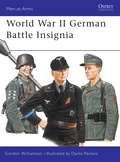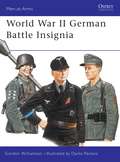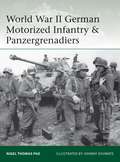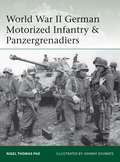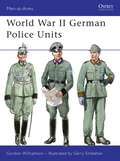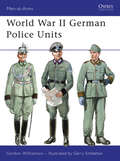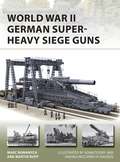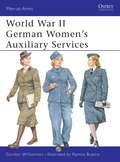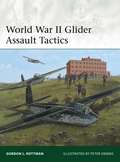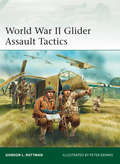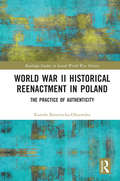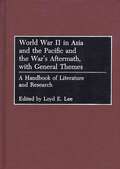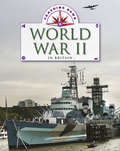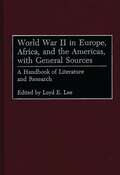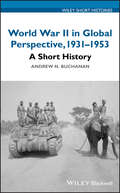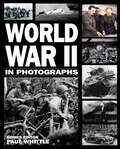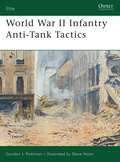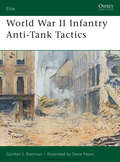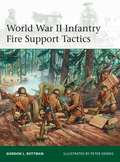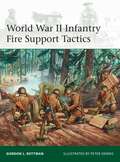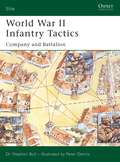- Table View
- List View
World War II German Battle Insignia (Men-at-Arms)
by Darko Pavlovic Gordon WilliamsonThe remarkable war effort of the German armed forces on three fronts between 1939 and 1945 was recognised by a wider range of insignia than seen in the Allied armies. While the Wehrmacht displayed fewer unit insignia than the Allies, a glance at a German soldier's tunic could reveal much more about his actual combat experience. In this book an experienced researcher explains and illustrates the Battle and Assault Badges of the Army, Waffen-SS and Luftwaffe ground troops; the sleeve shields and cuffbands issued to mark service in particular campaigns; wound badges, commemorative medals, and other types of insignia.
World War II German Battle Insignia (Men-at-Arms #365)
by Darko Pavlovic Gordon WilliamsonThe remarkable war effort of the German armed forces on three fronts between 1939 and 1945 was recognised by a wider range of insignia than seen in the Allied armies. While the Wehrmacht displayed fewer unit insignia than the Allies, a glance at a German soldier's tunic could reveal much more about his actual combat experience. In this book an experienced researcher explains and illustrates the Battle and Assault Badges of the Army, Waffen-SS and Luftwaffe ground troops; the sleeve shields and cuffbands issued to mark service in particular campaigns; wound badges, commemorative medals, and other types of insignia.
World War II German Motorized Infantry & Panzergrenadiers (Elite)
by Johnny Shumate Nigel ThomasIn World War II Germany's doctrine of mobile warfare dominated the battlefield. By trial and error, the Germans were the first to correctly combine the strength in tanks and in mobile infantry and artillery. This integration of mobile units, equipment and tactics underpinned Germany's successes in the first half of the war. As the war dragged on, the Allies sought to copy German tactics but German armies remained supreme in this type of warfare until their losses had seriously degraded their capabilities. This study traces the development of the different types of unit that came together in the Panzergrenadier branch from the inter-war years through World War II. Using colour plates to display the changes in uniform, equipment and insignia in all theatres of operations throughout the conflict, this is a complete account of Hitler's elite armoured infantry.
World War II German Motorized Infantry & Panzergrenadiers (Elite #218)
by Johnny Shumate Nigel ThomasIn World War II Germany's doctrine of mobile warfare dominated the battlefield. By trial and error, the Germans were the first to correctly combine the strength in tanks and in mobile infantry and artillery. This integration of mobile units, equipment and tactics underpinned Germany's successes in the first half of the war. As the war dragged on, the Allies sought to copy German tactics but German armies remained supreme in this type of warfare until their losses had seriously degraded their capabilities. This study traces the development of the different types of unit that came together in the Panzergrenadier branch from the inter-war years through World War II. Using colour plates to display the changes in uniform, equipment and insignia in all theatres of operations throughout the conflict, this is a complete account of Hitler's elite armoured infantry.
World War II German Police Units (Men-at-Arms)
by Gerry Embleton Gordon WilliamsonThe German Police were an essential arm of the Nazi regime; as soon as Hitler achieved power the previous decentralized provincial system was unified into a single state apparatus, integrated at the command levels with the SS. While it may have been centrally controlled, it was still separated into a bewildering range of different departments and functions, many with their own uniform distinctions. This book offers a concise introduction to the organization, responsibilities, uniforms and insignia of the various branches of this machinery of repression, from Police generals to rural constables, transport policemen and factory watchmen.
World War II German Police Units (Men-at-Arms #434)
by Gordon WilliamsonThe German Police were an essential arm of the Nazi regime; as soon as Hitler achieved power the previous decentralized provincial system was unified into a single state apparatus, integrated at the command levels with the SS. While it may have been centrally controlled, it was still separated into a bewildering range of different departments and functions, many with their own uniform distinctions. This book offers a concise introduction to the organization, responsibilities, uniforms and insignia of the various branches of this machinery of repression, from Police generals to rural constables, transport policemen and factory watchmen.
World War II German Super-Heavy Siege Guns (New Vanguard)
by Marc Romanych Martin RuppAs the outbreak of World War II approached, Nazi Germany ordered artillery manufacturers Krupp and Rheimetall-Borsig to build several super-heavy siege guns, vital to smash through French and Belgian fortresses that stood in the way of the Blitzkrieg. These 'secret weapons' were much larger than the siege artillery of World War I and included the largest artillery piece of the war, the massive 80cm railway gun 'schwere Gustav' (Heavy Gustav). However, these complex and massive artillery pieces required years to build and test and, as war drew near, the German High Command hastily brought several WWI-era heavy artillery pieces back into service and then purchased, and later confiscated, a large number of Czech Skoda mortars. The new super siege guns began entering service in time for the invasion of Russia, notably participating in the attack on the fortress of Brest-Litovsk. The highpoint for the siege artillery was the siege of Sevastopol in the summer of 1942, which saw the largest concentration of siege guns in the war. Afterwards, when Germany was on the defensive in the second half of 1943, the utility of the guns was greatly diminished, and they were employed in a piecemeal and sporadic fashion on both the Eastern and Western Fronts. In total, the German Army used some 50 siege guns during World War II, far more than the thirty-five it had during World War I. Supported by contemporary photographs and detailed artwork of the guns and their components, this is an essential guide to these guns, exploring their history, development, and deployment in stunning detail.
World War II German Super-Heavy Siege Guns (New Vanguard #280)
by Marc Romanych Martin RuppAs the outbreak of World War II approached, Nazi Germany ordered artillery manufacturers Krupp and Rheimetall-Borsig to build several super-heavy siege guns, vital to smash through French and Belgian fortresses that stood in the way of the Blitzkrieg. These 'secret weapons' were much larger than the siege artillery of World War I and included the largest artillery piece of the war, the massive 80cm railway gun 'schwere Gustav' (Heavy Gustav). However, these complex and massive artillery pieces required years to build and test and, as war drew near, the German High Command hastily brought several WWI-era heavy artillery pieces back into service and then purchased, and later confiscated, a large number of Czech Skoda mortars. The new super siege guns began entering service in time for the invasion of Russia, notably participating in the attack on the fortress of Brest-Litovsk. The highpoint for the siege artillery was the siege of Sevastopol in the summer of 1942, which saw the largest concentration of siege guns in the war. Afterwards, when Germany was on the defensive in the second half of 1943, the utility of the guns was greatly diminished, and they were employed in a piecemeal and sporadic fashion on both the Eastern and Western Fronts. In total, the German Army used some 50 siege guns during World War II, far more than the thirty-five it had during World War I. Supported by contemporary photographs and detailed artwork of the guns and their components, this is an essential guide to these guns, exploring their history, development, and deployment in stunning detail.
World War II German Women’s Auxiliary Services (Men-at-Arms #393)
by Ramiro Bujeiro Gordon WilliamsonUnder the Nazi regime, Hitler's conservative views on the place of housewives and mothers in society limited German women to a much less active role in the war than their British and Allied counterparts. Nevertheless, the demands of a prolonged war did see German women in a range of uniforms as auxiliaries with the Army, Navy, Air Force and SS, particularly in the signals and air defence services. This unique book explains and illustrates these organisations and their uniforms and insignia, as well as Red Cross nurses, and auxiliaries of the Labour Corps, Customs Service, National Socialist Women's Organisation, and League of German Maidens (Hitler Youth).
World War II German Women’s Auxiliary Services (Men-at-Arms #393)
by Ramiro Bujeiro Gordon WilliamsonUnder the Nazi regime, Hitler's conservative views on the place of housewives and mothers in society limited German women to a much less active role in the war than their British and Allied counterparts. Nevertheless, the demands of a prolonged war did see German women in a range of uniforms as auxiliaries with the Army, Navy, Air Force and SS, particularly in the signals and air defence services. This unique book explains and illustrates these organisations and their uniforms and insignia, as well as Red Cross nurses, and auxiliaries of the Labour Corps, Customs Service, National Socialist Women's Organisation, and League of German Maidens (Hitler Youth).
World War II Glider Assault Tactics (Elite)
by Peter Dennis Gordon L. RottmanMilitary gliders came of age in World War II, when glider assault infantry were the forerunners of today's helicopter-delivered airmobile troops. From the light pre-war sports and training machines, several nations developed troop-carrying gliders capable of getting a whole squad or more of infantry, with heavy weapons, onto the ground quickly, with the equipment that paratroopers simply could not carry. They made up at least one-third of the strength of US, British, and German airborne divisions in major battles, and they also carried out several daring coup de main raids and spearhead operations. However, the dangers were extreme, the techniques were difficult, the losses were heavy (particularly during night operations), and the day of the glider assault was relatively brief. This book explains the development and organization of glider troops, their mounts, and the air squadrons formed to tow them, the steep and costly learning-curve and the tactics that such troops learned to employ once they arrived on the battlefield.
World War II Glider Assault Tactics (Elite)
by Peter Dennis Gordon L. RottmanMilitary gliders came of age in World War II, when glider assault infantry were the forerunners of today's helicopter-delivered airmobile troops. From the light pre-war sports and training machines, several nations developed troop-carrying gliders capable of getting a whole squad or more of infantry, with heavy weapons, onto the ground quickly, with the equipment that paratroopers simply could not carry. They made up at least one-third of the strength of US, British, and German airborne divisions in major battles, and they also carried out several daring coup de main raids and spearhead operations. However, the dangers were extreme, the techniques were difficult, the losses were heavy (particularly during night operations), and the day of the glider assault was relatively brief. This book explains the development and organization of glider troops, their mounts, and the air squadrons formed to tow them, the steep and costly learning-curve and the tactics that such troops learned to employ once they arrived on the battlefield.
World War II Historical Reenactment in Poland: The Practice of Authenticity (Routledge Studies in Second World War History)
by Kamila Baraniecka-OlszewskaThis book explores the consequences of the latest political shifts in Central Eastern Europe: the rise of right-wing parties and, among other things, politics becoming more invested in history. These phenomena coincide and overlap with the democratisation of history by turning the past into a hot topic, persistently present in the public sphere and often evoking strong emotions. Ethnographic research (conducted in 2012-2016) focusing on how World War II reenactors experience the past serves as the basis to analyse the ways in which the group uses the widespread, often institutionalised interest in history to – on the one hand – become involved in debates on World War II and the remembrance thereof, and – on the other – to authentically experience this past. The volume therefore analyses how physical the process of creating and experiencing grassroots visions of the past is, and how these visions interact with the public discourse about the past. Reenactors’ ability to marry the often-contradictory orders of historical truth, authenticity, and representation is explored. Moreover, Baraniecka-Olszewska analyses how the reenactors overcome various obstacles on their way towards authentic experiences, performing history through their bodies.
World War II Historical Reenactment in Poland: The Practice of Authenticity (Routledge Studies in Second World War History)
by Kamila Baraniecka-OlszewskaThis book explores the consequences of the latest political shifts in Central Eastern Europe: the rise of right-wing parties and, among other things, politics becoming more invested in history. These phenomena coincide and overlap with the democratisation of history by turning the past into a hot topic, persistently present in the public sphere and often evoking strong emotions. Ethnographic research (conducted in 2012-2016) focusing on how World War II reenactors experience the past serves as the basis to analyse the ways in which the group uses the widespread, often institutionalised interest in history to – on the one hand – become involved in debates on World War II and the remembrance thereof, and – on the other – to authentically experience this past. The volume therefore analyses how physical the process of creating and experiencing grassroots visions of the past is, and how these visions interact with the public discourse about the past. Reenactors’ ability to marry the often-contradictory orders of historical truth, authenticity, and representation is explored. Moreover, Baraniecka-Olszewska analyses how the reenactors overcome various obstacles on their way towards authentic experiences, performing history through their bodies.
World War II in Asia and the Pacific and the War's Aftermath, with General Themes: A Handbook of Literature and Research
by Loyd LeeA companion to World War II in Europe, Africa, and the Americas, this volume reevaluates the most enduring literature on basic aspects of the war in Asia and the Pacific. It also covers themes pertaining to societies at war, culture, the arts, and science and technology as well as international relations and the postwar world. Included are not only grand strategy, military and naval campaigns, and matters of diplomacy, but also resistance, collaboration, prisoners of war, and broad topics of the home front, including chapters on gender issues, film, literature, popular culture, and propaganda. This volume and its companion provide the first comprehensive historiographic reference work on the war.Each chapter describes the state of knowledge on the topic, relating each bibliographic reference to the chapter's themes and issues, and concludes with a bibliography. Recent original scholarship is included when it aids new understanding, and older works of enduring value also find a place. The essays in this volume will interest scholars and college teachers as well as advanced students and serious amateurs seeking insight into the history of the war and its literature.
World War II in Britain: World War Ii In Britain (Tracking Down #13)
by Liz Gogerly'The past is all around us, if we know where to look.' This series takes a look at archaeological, structural and museum evidence from around Britain, allowing readers to build up a picture of what life was like in key historical periods and how you can discover it for yourself by visiting sites around the country.
World War II in Europe, Africa, and the Americas, with General Sources: A Handbook of Literature and Research
by Loyd LeeA broadly interdisciplinary work, this handbook discusses the best and most enduring literature related to the major topics and themes of World War II. Military historiography is treated in essays on the major theaters of military operations and the related themes of logistics and intelligence, while political and diplomatic history is covered in chapters on international relations, resistance movements, and collaboration. The volume analyzes themes of domestic history in essays on economic mobilization, the home fronts, and women in the military and civilian life. The book also covers the Holocaust.This handbook approaches each topic from a global viewpoint rather than focusing on individual national communities. Except for nonprint material, the literature, research, and sources surveyed are primarily those available in English. The volume is aimed at both experts on the war and the general academic community and will also be useful to students and serious laymen interested in the war.
World War II in Global Perspective, 1931-1953: A Short History (Wiley Short Histories)
by Andrew N. BuchananA comprehensive review of World War II that offers a global-level analysis Written for academics and students of history, World War II in Global Perspective, 1931-1953 presents a dynamic and global account of the historical events prior to, during, and after World War II. The author—a noted expert on the topic—explores the main theaters of the war and discusses the connections between them. He also examines the impact of the war on areas of the world that are often neglected in historical accounts, including Latin America, sub-Saharan Africa, and the so-called ‘neutral’ countries. This comprehensive text clearly shows how in the struggle against the Axis powers, the United States replaced Britain as the global superpower. The author discusses the Japanese invasion of Manchuria in 1931 and the Korean War (1950-1953) and argues that the core years of the war (1939-1945) cannot be understood without considering the turbulent events that framed them. The text puts World War II in context as a series of large regional conflicts that intersected and overlapped, finally emerging as a genuine “world war” with the formal entry of the United States in late 1941. This vital text: Offers a comprehensive review of World War II that frames it in a global context Gives weight to the economic and political developments of the war Provides a robust account of the main military campaigns Contains illustrations and maps that themselves highlight little-known aspects of the global war
World War II in Global Perspective, 1931-1953: A Short History (Wiley Short Histories)
by Andrew N. BuchananA comprehensive review of World War II that offers a global-level analysis Written for academics and students of history, World War II in Global Perspective, 1931-1953 presents a dynamic and global account of the historical events prior to, during, and after World War II. The author—a noted expert on the topic—explores the main theaters of the war and discusses the connections between them. He also examines the impact of the war on areas of the world that are often neglected in historical accounts, including Latin America, sub-Saharan Africa, and the so-called ‘neutral’ countries. This comprehensive text clearly shows how in the struggle against the Axis powers, the United States replaced Britain as the global superpower. The author discusses the Japanese invasion of Manchuria in 1931 and the Korean War (1950-1953) and argues that the core years of the war (1939-1945) cannot be understood without considering the turbulent events that framed them. The text puts World War II in context as a series of large regional conflicts that intersected and overlapped, finally emerging as a genuine “world war” with the formal entry of the United States in late 1941. This vital text: Offers a comprehensive review of World War II that frames it in a global context Gives weight to the economic and political developments of the war Provides a robust account of the main military campaigns Contains illustrations and maps that themselves highlight little-known aspects of the global war
World War II in Photographs
by Andrew WebbWorld War II in Photographs is an innovative visual account of the major events of the greatest conflict of the twentieth century, the Second World War. Featuring over 250 original images of warfare in all its forms, the book portrays the significant actions and people of the years 1939-1945. From Dunkirk to D-Day, Churchill to Crete, Rommel to Russia, every aspect of the conflict is examined in astonishing visual detail.
World War II Infantry Anti-Tank Tactics (Elite #124)
by Steve Noon Gordon L. RottmanThe battlefield interaction between infantry and tanks was central to combat on most fronts in World War II. The first 'Blitzkrieg' campaigns saw the tank achieve a new dominance. New infantry tactics and weapons – some of them desperately dangerous – had to be adopted, while the armies raced to develop more powerful anti-tank guns and new light weapons. By 1945, a new generation of revolutionary shoulder-fired AT weapons was in widespread use. This book explains in detail the shifting patterns of anti-tank combat, illustrated with photographs, diagrams and colour plates showing how weapons were actually employed on the battlefield.
World War II Infantry Anti-Tank Tactics (Elite #124)
by Gordon L. RottmanThe battlefield interaction between infantry and tanks was central to combat on most fronts in World War II. The first 'Blitzkrieg' campaigns saw the tank achieve a new dominance. New infantry tactics and weapons – some of them desperately dangerous – had to be adopted, while the armies raced to develop more powerful anti-tank guns and new light weapons. By 1945, a new generation of revolutionary shoulder-fired AT weapons was in widespread use. This book explains in detail the shifting patterns of anti-tank combat, illustrated with photographs, diagrams and colour plates showing how weapons were actually employed on the battlefield.
World War II Infantry Fire Support Tactics (Elite)
by Peter Dennis Gordon L. RottmanAs infantry units advanced across Europe the only support they could rely on from day to day was that provided by the heavy weapons of their own units. While thundering tanks struck fear into the hearts of their enemies it was the machine guns, mortars and light cannon that proved to be most important, causing the majority of casualties suffered during World War II. Common principles were shared across units but the wide variety of weapons available to the different armies altered the way they were used in battle.Focusing on the US, British, German and Soviet troops, this title offers a comprehensive guide to infantry fire support tactics used through World War II. Combat reports are complemented by specially commissioned artwork to show the way in which tactics varied, and highlight how developments obliged opposing armies to review their own methods.
World War II Infantry Fire Support Tactics (Elite #214)
by Gordon L. RottmanAs infantry units advanced across Europe the only support they could rely on from day to day was that provided by the heavy weapons of their own units. While thundering tanks struck fear into the hearts of their enemies it was the machine guns, mortars and light cannon that proved to be most important, causing the majority of casualties suffered during World War II. Common principles were shared across units but the wide variety of weapons available to the different armies altered the way they were used in battle.Focusing on the US, British, German and Soviet troops, this title offers a comprehensive guide to infantry fire support tactics used through World War II. Combat reports are complemented by specially commissioned artwork to show the way in which tactics varied, and highlight how developments obliged opposing armies to review their own methods.
World War II Infantry Tactics: Company and Battalion (Elite)
by Stephen BullWorld War II is often seen as a confrontation of technology – tanks and aircraft, artillery and engineering. But at the heart of the battlefield was the struggle between infantrymen, and the technology was there to enable them to capture ground or hold it. This second of two books on the organization and tactics of the German, US and British infantry in Europe focuses on national differences in the development of company and battalion tactics – including those of motorized units – and the confrontation and co-operation between infantry and tanks. Contemporary photos and diagrams and vivid colour plates illustrate what tactical theories actually meant on the ground at human scale.
